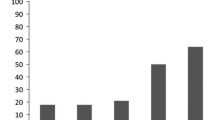Abstract
Raymond Garcin, professor of neurology in Paris, France, and his Brazilian assistant, Professor Roberto Melaragno described in 1948 the phenomenon defined as “bégaiement de la mise en route du mouvement” in patients with Parkinson’s disease. This was one of the first descriptions of freezing of gait (FOG) in the world.



Similar content being viewed by others
References
Barthel C, Mallia E, Debû B, Bloem BR (2016) The practicalities of assessing freezing of gait. J Park Dis 6:667–674
Giladi N, Nieuwboer A (2008) Understanding and treating freezing of gait in parkinsonism, proposed working definition, and setting the stage. Mov Disord 23(Suppl 2):S423–S425
Garcia Ruiz PJ (2011) Gait disturbances in Parkinson disease. Did freezing of gait exist before levodopa? Historical review. J Neurol Sci 307(1–2):15–17
Foley P. Mind the gap: response to Garcia-Ruiz PJ (2011) Gait disturbances in Parkinson disease. Did freezing of gait exist before levodopa? J Neurol Sci 307: 15–17. J Neurol Sci 2012; 323 (1–2): 266; author reply 267
Melaragno Filho R (1971) Prof. Raymond Garcin (1897–1971). Arq Neuropsiquiatr 29(3):373–374
Garcin R (1927) Le syndrome paralytique unilatéral global des nerfs crâniens: contribution à l’étude des tumeurs de la base du crâne. Thèse Paris n°34. Paris: A. Legrand
Limongi JCP, Lima PMG, Silva SMCA, Ferreira MG, Barbosa ER, Teive HAG (2021) Roberto Melaragno’s scientific contributions to Brazilian neurology. Arq Neuropsiquiatr 79(2):175–177
Garcin R (1949) Discussion sur A propos des manifestations neurologiques tardives des intoxications oxycarbonées; démarche à petits pas et astasie-abasie trépidante par hypertonie extrapyramidale du plain musculaire antigravifique, par Alajouanine TH Boudin G et Flavigny. Rev Neurol 81:76–77
Melaragno FR (1948) Sur quelques aspects des troubles de la dénervation volontaire – enrayage cinétique, persévération tonique, “Bégaiement de la mise en route du mouvement”, piétinement – observés dans les syndromes extrapyramidaux et sur leur relation avec quelques autres phénomenes analogues observes en neuropathologie. Arq Neuropsiquiar 6(4):334–351
Nieuwboer A, Kwakkel G, Rochester L, Jones D, van Wegen E, Willems AM, Chavret F, Hetherington V, Baker K, Lim I (2007) Cueing training in the home improves gait-related mobility in Parkinson’s disease: the RESCUE trial. J Neurol Neurosurg Psychiatry 78(2):134–140. https://doi.org/10.1136/jnnp.200X.097923
Author information
Authors and Affiliations
Contributions
The authors alone are responsible for the content and writing of this paper.
Corresponding author
Ethics declarations
Ethical approval
None.
Conflict of interest
The authors declare no competing interests.
Additional information
Publisher’s note
Springer Nature remains neutral with regard to jurisdictional claims in published maps and institutional affiliations.
Rights and permissions
About this article
Cite this article
Teive, H.A.G., Cunha, P., Ferreira, M.G. et al. Freezing of gait (FOG) in Parkinson’s disease patients—the contribution of Garcin and Melaragno. Neurol Sci 42, 5413–5417 (2021). https://doi.org/10.1007/s10072-021-05381-1
Received:
Accepted:
Published:
Issue Date:
DOI: https://doi.org/10.1007/s10072-021-05381-1




